Articles
- Page Path
- HOME > Korean J Community Nutr > Volume 17(4); 2012 > Article
-
Original Article
- Comparison of Food and Nutrient Consumption Status between Displaced North Korean Children in South Korea and South Korean Children
- Soo-Kyung Lee, So-Young Nam
-
Korean Journal of Community Nutrition 2012;17(4):407-418.
DOI: https://doi.org/10.5720/kjcn.2012.17.4.407
Published online: August 31, 2012
Department of Food and Nutrition, Inha University, Incheon, Korea.
- Corresponding author: Soo-Kyung Lee, Department of Food and Nutrition, Inha University, 100 Inharo, Namgu, Incheon 402-751, Korea. Tel: (032) 860-8121, Fax: (032) 862-8120, skleenutrition@inha.ac.kr
Copyright © 2012 The Korean Society of Community Nutrition
- 157 Views
- 1 Download
- 8 Crossref
Abstract
- Many displaced North Koreans (NK) are living in South Korea (SK); however nutrition research with the displaced NK is limited. This study examined food and nutrient consumption status of displaced NK children (6-18 year-old) currently living in SK. A total of 154 children were recruited, and a pre-tested dietary behavior questionnaire, food frequency questionnaire, 24-hr recall method were used. Sex- and age-matched SK children (n = 462) randomly selected from 2009-2010 Korea National Health and Nutrition Examination Survey were used as the comparison group. This study found that more NK children skipped breakfast (37%) and dinner (11%), and ate breakfast (38.8%) and dinner (18.2%) without family members than SK children. Many NK children reported that they rarely ate bread, rice cake, hamburger, pizza, fried food, candy. NK children consumed significantly less energy and nutrients (except calcium) and obtained more energy from fat and protein than SK children. Overall index of nutrient quality in NK children, however, was generally good. Length of stay in SK and breakfast skipping rates were significantly associated with lower diet quality. Therefore, nutrition education with displaced NK children should target those who recently came to SK. How to incorporate "new" foods, generally high in energy, sugar, or fat, in healthy ways and importance of breakfast should be emphasized. The growth patterns of the displaced NK children who were born and raised in food-deprived environments and will grow in food-affluent environments of SK should be monitored for health promotion of the NK children and for nutrition policy of the future united Korea.
-
This research was supported by the National Research Foundation of Korea (NRF) grant funded by the Korea government (MEST).
NOTES
- 1. Barker DJP. Fetal and infant origins of adult disease. 1992; London: British Medical Journal Publishing.
- 2. Barker DJP. Mothers, babies, and diseases in later life. 1994; London: British Medical Journal Publishing.
- 3. Beardsworth A, Keil T. Sociology on the menu. 1997; London: Routledge.
- 4. Chang N, Jo D, Hwang J, Kang E. Assessment of health and nutritional status of North Koreans utilizing an exhaustive literature search and survey. Korean J Nutr. 1998; 31(8): 1338-1346.
- 5. Chang N, Kang EY, Lee JM, Lee MK. Anthropometric measurements and dietary patterns of North Korean migrant children in China. Korean J Nutr. 2000a; 33(3): 324-331.
- 6. Chang N, Hwang JY. Food shortage, nutritional deprivation, and reduced body size in North Korean defectors. Korean J Nutr. 2000b; 33(5): 540-547.
- 7. Choi SK, Park SM, Jung H. Still life with less: North Korean young adult defectors in South Korea show continued poor nutrition and physique. Nutr Res Pract. 2010; 4(2): 136-141.ArticlePubMedPMC
- 8. Choue RW, Hong JY, Yim JE. The changes of dietary intakes in the defectors from North Korea. Korean J Community Nutr. 1997; 2(4): 470-476.
- 9. DPRK Central Bureau of Statistics. Report on the DPRK nutrition assessment, 2002. 2002; cited 2012 June 15. Available from http://www.unicef.org/dprk/resources_254.html.
- 10. DPRK Central Bureau of Statistics. DPRK 2004 nutrition assessment Report of survey results. 2005; cited 2012 June 15. Available from http://www.unicef.org/dprk/resources_254.html.
- 11. FAO, WFP. FAO/WFP crop and food security assessment mission to the democratic peopleís republic of Korea. 2011; cited 2012 June 15. Available from http://www.wfp.org/content/dpr-korea-faowfp-crop-and-food-security-assessment-november-2011.
- 12. Gibson RS. Principles of nutritional assessment. 1990; 2nd ed. Oxford: Oxford University Press.
- 13. Gluckman P, Hanson M. Developmental origins of health and disease. 2006; Cambridge: Cambridge University Press.
- 14. Hoffman DJ, Sawaya AL, Verreschi I, Tucker KL, Roberts SB. Why are nutritionally stunted children at increased risk of obesity? Studies of metabolic rate and fat oxidation in shantytown children from Sao Paulo, Brazil. Am J Clin Nutr. 2000; 72(3): 702-707.PubMed
- 15. Hwang JY, Chang N. Dietary patterns and nutrient intake in North Koreans by utilizing literature search and survey. Korean J Community Nutr. 2001; 6(3): 371-379.
- 16. Kim SG. Physical health status of North Korean migrants in South Korea. 2011 International Conference on the Health of North Korean Migrants. 2011; 97-118.
- 17. Korea Center for Disease Control and Prevention & The Korean Pediatric Society. 2007 Korean National Growth Charts. 2007; cited 2012 June 15. Available from www.cdc.go.kr.
- 18. Korea Centers for Disease Control and Prevention. The Fourth Korea National Health and Nutrition Examination Survey (KNHANES VI-3), 2009. 2009.
- 19. Korea Centers for Disease Control and Prevention. The Fifth Korea National Health and Nutrition Examination Survey (KNHANES V-1), 2010. 2010.
- 20. Lee SK, Sobal J, Frongillo EA. Acculturation, Food Consumption, and Diet-related factors among Korean Americans. J Nutr Educ. 1999; 31(6): 321-330.Article
- 21. Lee SK, Sobal J, Frongillo EA. Acculturation and Health in Korean Americans. Soc Sci & Med. 2000; 51(2): 159-173.Article
- 22. Lee SK. Dietary acculturation in Korean Americans. J Community Nutr. 2003; 5(4): 246-253.
- 23. Ministry of Unification. 2012 Unification white paper. 2012; cited 2012 June 04. Available from http://www.unikorean.go.kr.
- 24. Ministry of Unification. The statistic of displaced North Korean. 2012; cited 2012 June 04. Available from http://www.unikorean.go.kr.
- 25. North Korea Central Bureau of Statistics & UNICEF. Demographic Peopleís Republic of Korea: Multiple indicator cluster survey, 2009. 2010; Poyngyang, DPR Korea.
- 26. Park YS, Rhee KC, Lee KY, Rhee EY, Yi SH, Kim DN, Choi YS. A glance at the health status and food intake of North Koreans. Korean J Community Nutr. 1997; 2(3): 396-405.
- 27. Park YS, Rhee KC, Lee KY, Rhee EY, Yi SH, Kim DN, Choi YS, Seok D. Dietary living in North Korea according to the defectors. Korean J Community Nutr. 1999; 4(1): 64-73.
- 28. Satia-Abouta J, Patterson RE, Neuhouser ML, Elder J. Dietary acculturation: applications to nutrition research and dietetics. J Am Diet Assoc. 2002; 102(8): 1105-1118.ArticlePubMed
- 29. Shim JE. Dietary quality of future Korea after reunification. Quality improvement of family life quality improvement of North Koreans in reunited Korea. 2011; Incheon, Korea: Conference proceeding; 15-30.
- 30. Shim JE, Yoon J, Jeong SY, Park M, Lee YS. Status of early childhood and maternal nutrition in South Korea and North Korea. Korean J Community Nutr. 2007; 12(2): 123-132.
- 31. The Korean Nutrition Society. Dietary reference intakes for Koreans. 2010; Seoul: The Korean Nutrition Society; 33-43.
- 32. Yeoh YJ, Yoon JH, Shim JE. Relation of breakfast intake to diet quality in Korean school-aged children: analysis of the data from the 2001 National Health and Nutrition Survey. Korean J Community Nutr. 2009; 14(1): 1-11.
REFERENCES
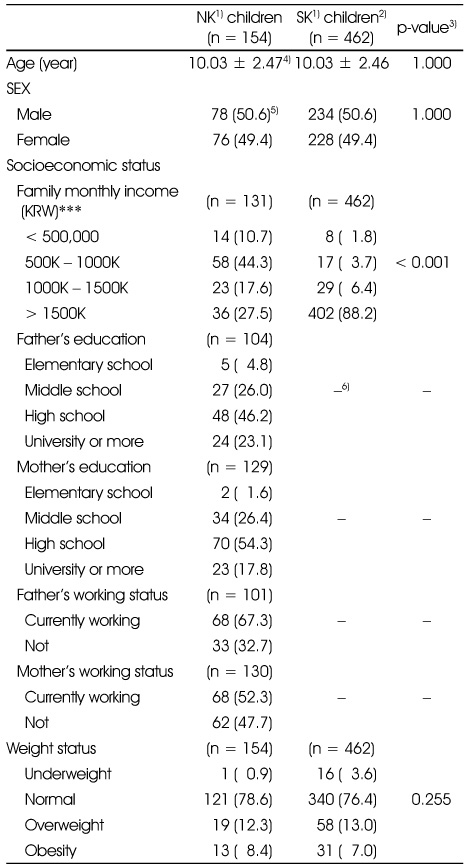
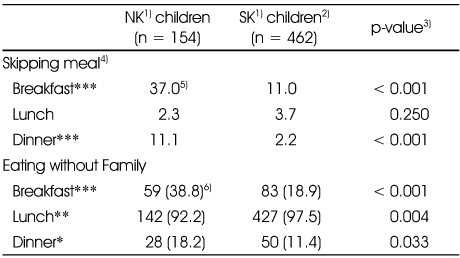
1) NK: North Korean, SK: South Korean
2) 2009-2010 Korean National Health and Nutrition Survey (6-18 years)
3) χ2-test
4) Skipping meal: Meal skipping rates were calculated from two-day data, therefore, only average percentages are presented in the table.
5) %
6) N (%)
*: P < 0.05, **: P < 0.01, ***: P < 0.001
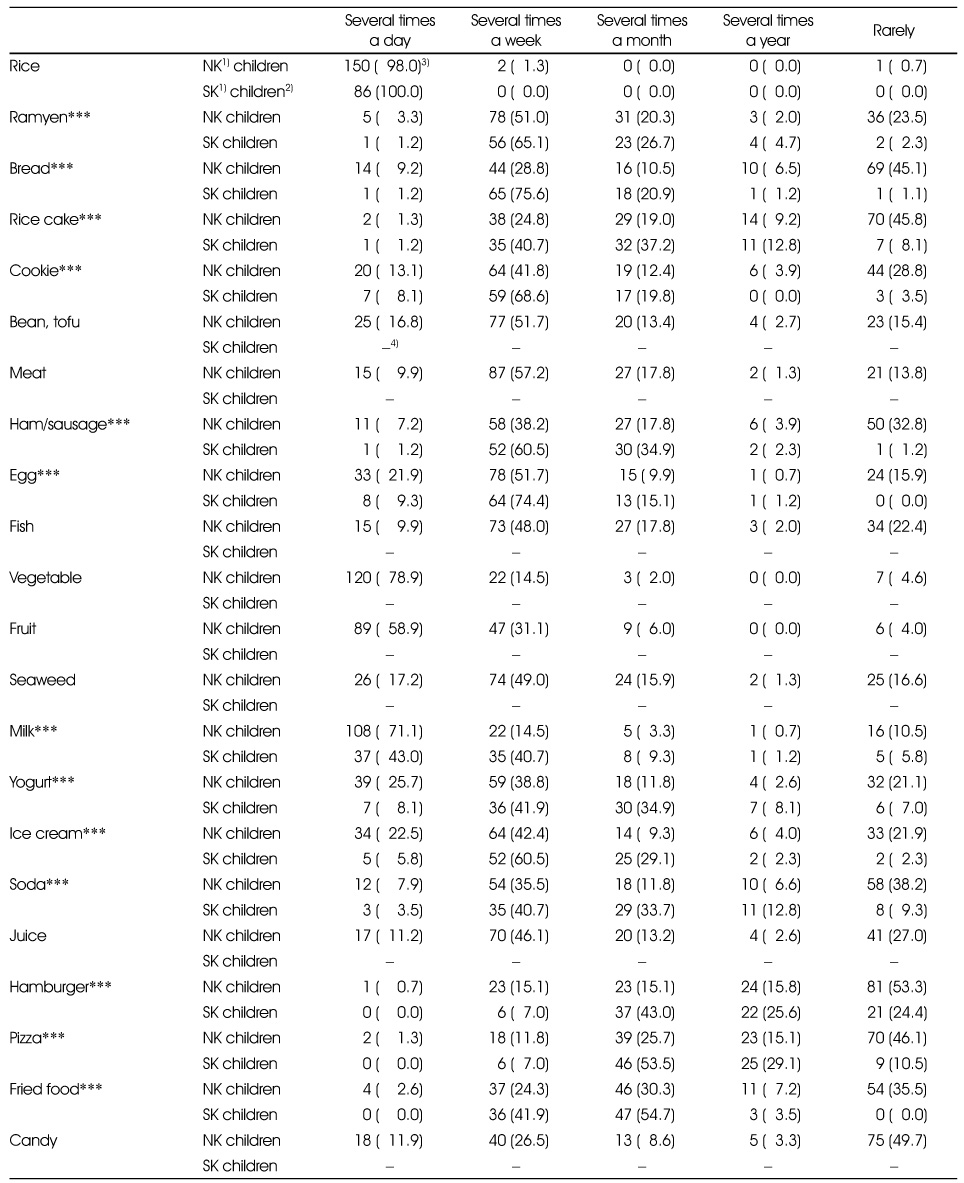
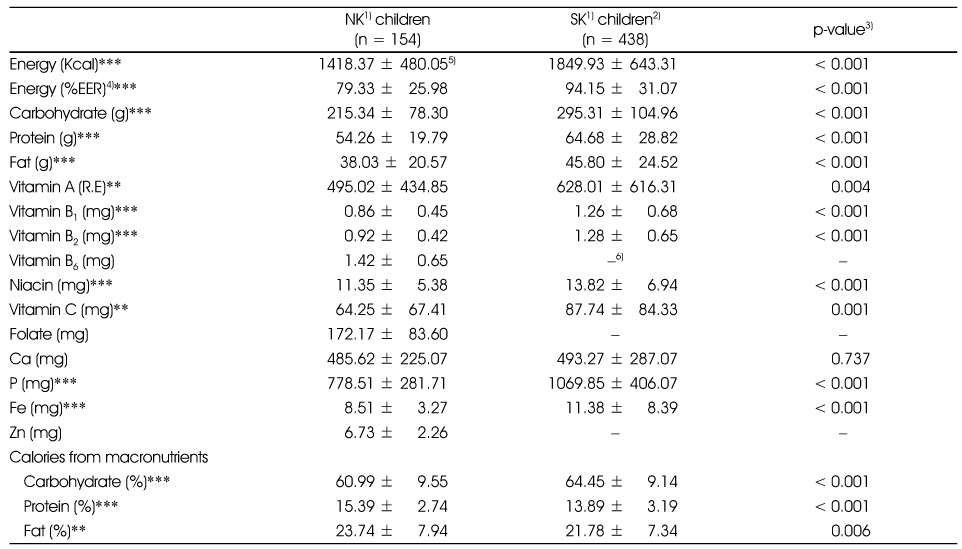
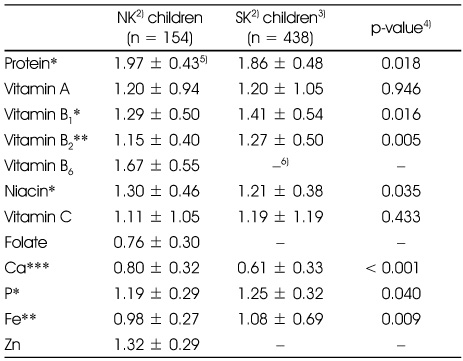
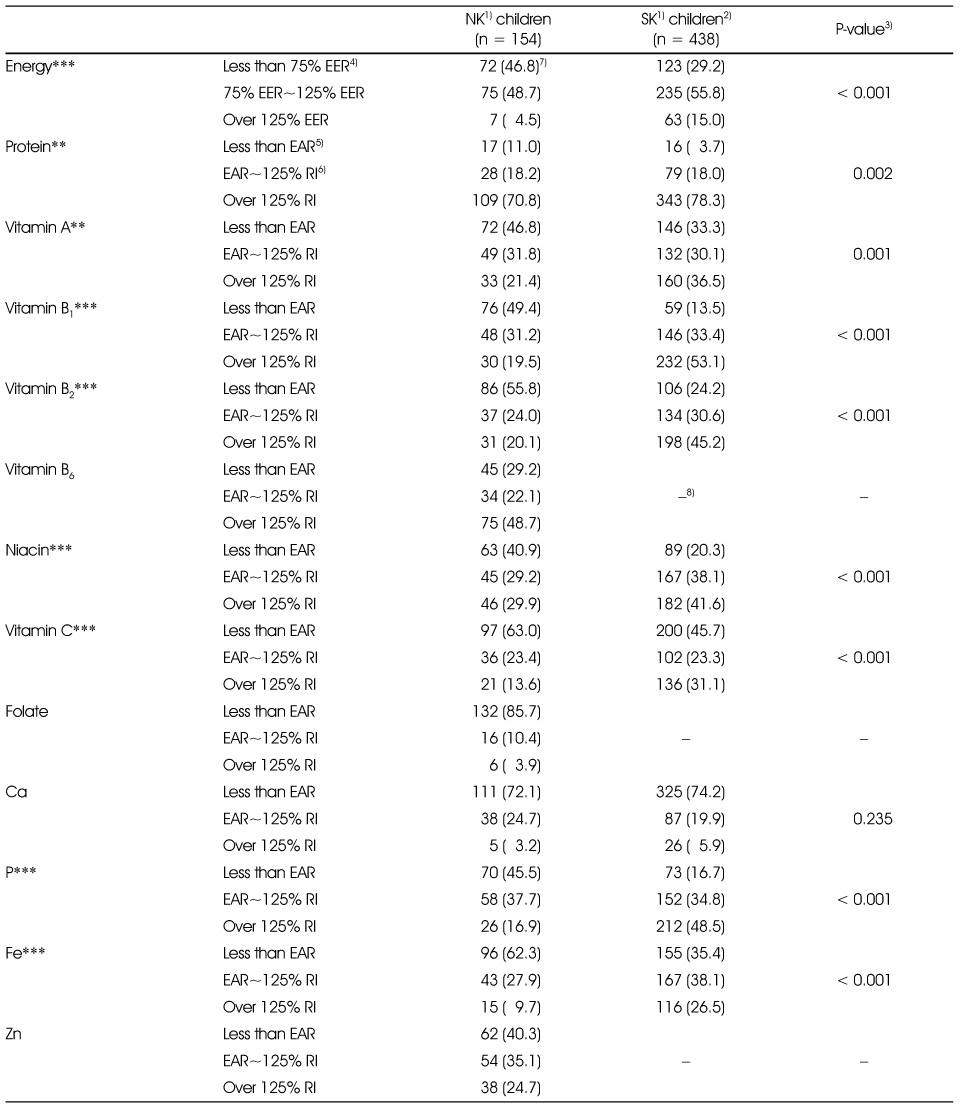
1) NK: North Korean, SK: South Korean
2) 2009-2010 Korean National Health and Nutrition Survey (6-18 years)
3) χ2-test
4) EER = Estimated Energy Requirements
5) EAR = Estimates Average Requirements
6) RI = Recommended Intake
7) N (%)
8) Information not available in KNHANES
**: P < 0.01, ***: P < 0.001
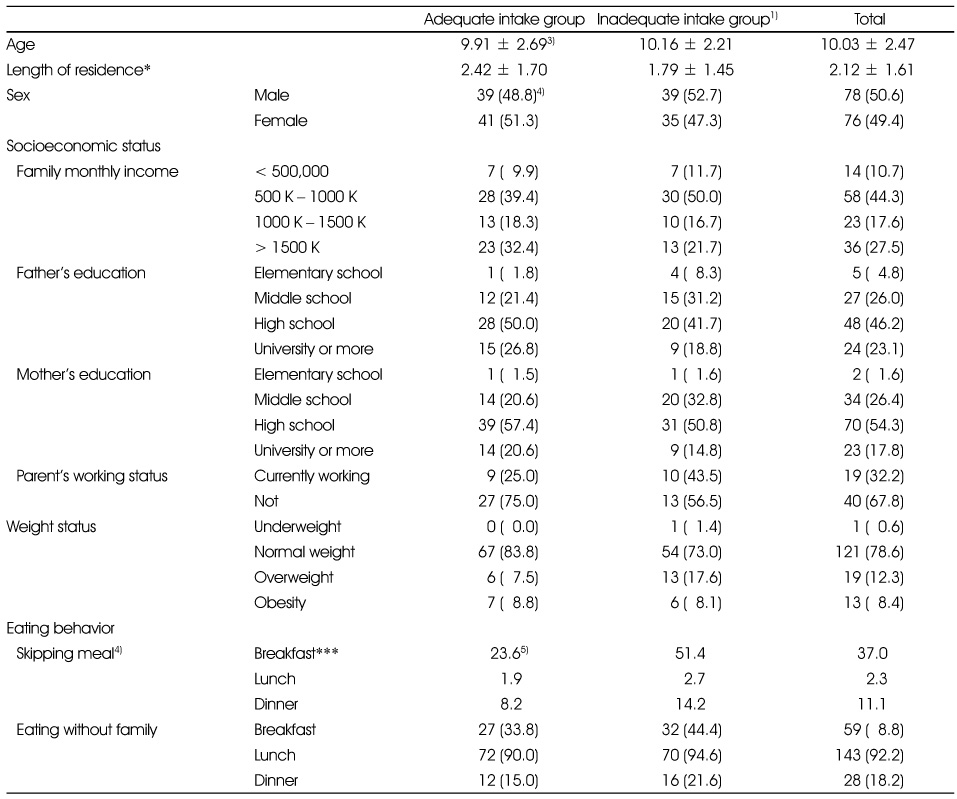
1) Inadequate intake group: children with more than seven energy and nutrients consuming less than 75% EER and EAR
2) Meal skipping rate: Meal skipping rates were calculated from two-day data, therefore, only average percentages are presented in the table.
3) Mean ± SD
4) N (%)
5) %
*: P < 0.05, ***: P < 0.001, Significantly differ by χ2-test or Fisher's exact test
Figure & Data
REFERENCES
Citations

- Changes in the Prevalence of Malnutrition and Obesity of Children from North Korean Refugee Families in South Korea: Three Repeated Surveys from 2017 to 2023
Seong-Woo Choi, So-Yeong Kim
Journal of Health Informatics and Statistics.2024; 49(3): 224. CrossRef - Changes in the Nutritional Status of Children from North Korean Refugee Families Following Resettlement in South Korea
So-Yeong Kim, Hyae-Min Gu, Seong-Woo Choi
Journal of The Korean Society of Maternal and Child Health.2023; 27(2): 102. CrossRef - Growth and Nutritional Status of Children in North Korean Refugee Families
Seong-Woo Choi
Journal of The Korean Society of Maternal and Child Health.2020; 24(2): 96. CrossRef - Double burden of malnutrition and obesity in children and adolescents from North Korean refugee families
So-Young Kim, Seong-Woo Choi, Madhavi Bhargava
PLOS ONE.2020; 15(11): e0241963. CrossRef - Changes in body weight and food security of adult North Korean refugees living in South Korea
HaYoung Jeong, Soo-Kyung Lee, Sin-Gon Kim
Nutrition Research and Practice.2017; 11(4): 307. CrossRef - Growth retardation at early life and metabolic adaptation among North Korean children
S.-K. Lee, S.-Y. Nam, D. J. Hoffman
Journal of Developmental Origins of Health and Disease.2015; 6(4): 291. CrossRef - Food security experiences of displaced North Korean households
Soo-Kyung Lee, So-Young Nam
Nutrition Research and Practice.2014; 8(2): 198. CrossRef - Food security experiences of displaced North Korean households
Soo-Kyung Lee, So-Young Nam
Nutrition Research and Practice.2014; 8(2): 198. CrossRef
General characteristics of displaced North Korean (NK) children and South Korean(SK) children
1) NK: North Korean, SK: South Korean
2) 2009-2010 Korean National Health and Nutrition Survey (6-18 years)
3) Student's t-test, χ2-test or Fisher's exact test
4) Mean ± SD
5) N (%)
6) Parent's information not available in 2010 KNHANES
***: P < 0.001
Eating behaviors of displaced North Korean (NK) children and South Korean (SK) children
1) NK: North Korean, SK: South Korean
2) 2009-2010 Korean National Health and Nutrition Survey (6-18 years)
3) χ2-test
4) Skipping meal: Meal skipping rates were calculated from two-day data, therefore, only average percentages are presented in the table.
5) %
6) N (%)
*: P < 0.05, **: P < 0.01, ***: P < 0.001
Food consumption frequency of displaced North Korean (NK) children and South Korean (SK) children
1) NK: North Korean, SK: South Korean
2) 2009-2010 Korean National Health and Nutrition Survey (12-18 years)
3) N (%)
4) Information not available in KNHANES
***: P < 0.001, by χ2-test or Fisher's exact test
Average intake of energy and nutrients of displaced North Korean (NK) children and South Korean (SK) children
1) NK: North Korean, SK: South Korean
2) 2009-2010 Korean National Health and Nutrition Survey (6-18 years)
3) Studentís t-test
4) EER = Estimated Energy Requirement
5) Mean ± SD
6) Information not available in KNHANES
**: P < 0.01, ***: P < 0.001
Index of Nutrient Quality1) (INQ) of displaced North Korean (NK) children and South Korean (SK) children
1) INQ: nutrient intake amount per 1000 kcal/RI per 1000 kcal
2) NK: North Korean, SK: South Korean
3) 2009-2010 Korean National Health and Nutrition Survey (6-18 years)
4) Studentís t-test
5) Mean ± SD
6) Information not available in KNHANES
*: P < 0.05, **: P < 0.01, ***: P < 0.001
Energy and nutrient intake status of displaced North Korean (NK) children and South Korean (SK) children
1) NK: North Korean, SK: South Korean
2) 2009-2010 Korean National Health and Nutrition Survey (6-18 years)
3) χ2-test
4) EER = Estimated Energy Requirements
5) EAR = Estimates Average Requirements
6) RI = Recommended Intake
7) N (%)
8) Information not available in KNHANES
**: P < 0.01, ***: P < 0.001
General characteristics by intake level in displaced North Korean (NK) children
1) Inadequate intake group: children with more than seven energy and nutrients consuming less than 75% EER and EAR
2) Meal skipping rate: Meal skipping rates were calculated from two-day data, therefore, only average percentages are presented in the table.
3) Mean ± SD
4) N (%)
5) %
*: P < 0.05, ***: P < 0.001, Significantly differ by χ2-test or Fisher's exact test
1) NK: North Korean, SK: South Korean 2) 2009-2010 Korean National Health and Nutrition Survey (6-18 years) 3) Student's t-test, χ2-test or Fisher's exact test 4) Mean ± SD 5) N (%) 6) Parent's information not available in 2010 KNHANES ***: P < 0.001
1) NK: North Korean, SK: South Korean 2) 2009-2010 Korean National Health and Nutrition Survey (6-18 years) 3) χ2-test 4) Skipping meal: Meal skipping rates were calculated from two-day data, therefore, only average percentages are presented in the table. 5) % 6) N (%) *: P < 0.05, **: P < 0.01, ***: P < 0.001
1) NK: North Korean, SK: South Korean 2) 2009-2010 Korean National Health and Nutrition Survey (12-18 years) 3) N (%) 4) Information not available in KNHANES ***: P < 0.001, by χ2-test or Fisher's exact test
1) NK: North Korean, SK: South Korean 2) 2009-2010 Korean National Health and Nutrition Survey (6-18 years) 3) Studentís t-test 4) EER = Estimated Energy Requirement 5) Mean ± SD 6) Information not available in KNHANES **: P < 0.01, ***: P < 0.001
1) INQ: nutrient intake amount per 1000 kcal/RI per 1000 kcal 2) NK: North Korean, SK: South Korean 3) 2009-2010 Korean National Health and Nutrition Survey (6-18 years) 4) Studentís t-test 5) Mean ± SD 6) Information not available in KNHANES *: P < 0.05, **: P < 0.01, ***: P < 0.001
1) NK: North Korean, SK: South Korean 2) 2009-2010 Korean National Health and Nutrition Survey (6-18 years) 3) χ2-test 4) EER = Estimated Energy Requirements 5) EAR = Estimates Average Requirements 6) RI = Recommended Intake 7) N (%) 8) Information not available in KNHANES **: P < 0.01, ***: P < 0.001
1) Inadequate intake group: children with more than seven energy and nutrients consuming less than 75% EER and EAR 2) Meal skipping rate: Meal skipping rates were calculated from two-day data, therefore, only average percentages are presented in the table. 3) Mean ± SD 4) N (%) 5) % *: P < 0.05, ***: P < 0.001, Significantly differ by χ2-test or Fisher's exact test

 KSCN
KSCN
 PubReader
PubReader Cite
Cite


